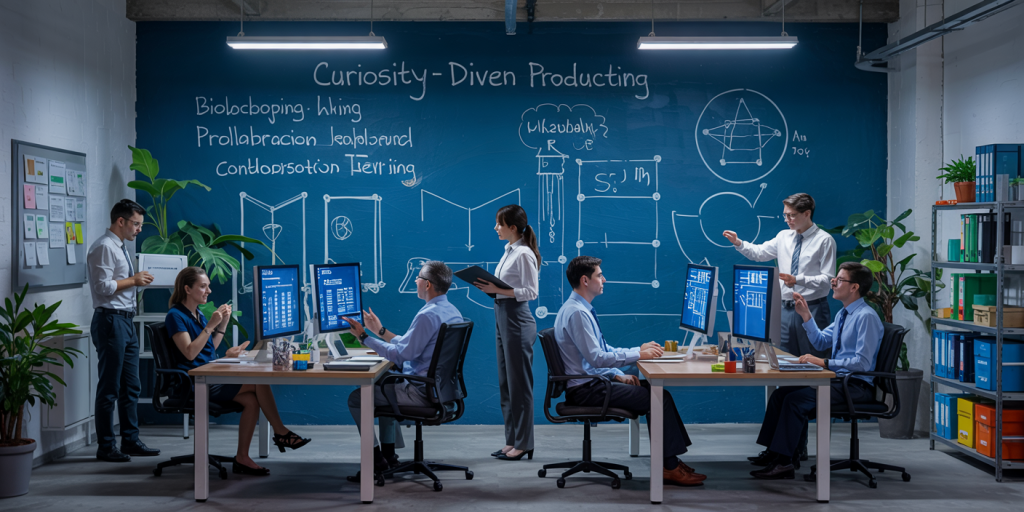The Role of Curiosity in Personal and Professional Success
Curiosity is an innate human trait that fuels the desire to learn, explore, and understand the world around us. It often serves as the foundation for innovation, creativity, and problem-solving abilities, which are critical for thriving in both personal and professional spheres. In today’s rapidly changing society, where adaptability and continuous learning are prized, curiosity becomes a crucial driver of success. Understanding the multifaceted role of curiosity can help individuals harness its potential to achieve meaningful growth and accomplishment.
Numerous studies underline the importance of curiosity in promoting cognitive development and emotional well-being. According to a 2022 Gallup survey, employees who described themselves as “curious learners” were 15% more productive and 21% more satisfied with their jobs compared to less curious colleagues. This highlights how a curious mindset not only enhances personal fulfillment but also improves professional outcomes. The subsequent sections delve into how curiosity influences personal growth, professional development, innovation, leadership, and future trends.
Curiosity as a Catalyst for Personal Growth
Personal growth is largely driven by the continuous desire to acquire knowledge and refine skills. Curiosity impels individuals to seek new experiences and question existing paradigms, leading to a richer understanding of themselves and the world around them. For example, lifelong learners often attribute their personal happiness and emotional resilience to their curious nature, as it encourages openness and adaptability.
Real-life examples illustrate curiosity’s power in personal development. Consider Malala Yousafzai, whose inquisitiveness about education and justice propelled her into global activism at a young age. Her relentless pursuit of knowledge and answers, despite life-threatening challenges, underscores how curiosity can become a transformative personal strength. Moreover, studies by psychologists like Todd Kashdan emphasize that curious individuals experience increased life satisfaction and reduced anxiety, as they view challenges as opportunities rather than threats.
Cultivating curiosity starts with adopting a mindset that values questions as much as answers. Simple practices such as journaling questions, exploring unfamiliar hobbies, and engaging with diverse ideas foster a curious nature that enriches personal development. This continual growth not only improves emotional health but also expands social connections, as curious individuals tend to be better conversationalists and collaborators.
Curiosity and Professional Excellence
In the professional arena, curiosity separates good employees from exceptional innovators and leaders. A curious professional exhibits a proactive attitude toward problem-solving and a keen interest in mastering new skills, which are highly valued in fast-paced industries. For instance, Google’s well-known “20% time” policy encourages employees to dedicate part of their workweek to projects outside their core responsibilities, harnessing curiosity to fuel innovation. This approach has led to revolutionary products like Gmail and Google News.
Research from McKinsey & Company found that companies fostering a culture of curiosity and continuous learning report 30% higher customer satisfaction and 42% greater shareholder returns on average. This statistic highlights how curiosity, when embedded in organizational culture, drives not only individual but also corporate success. Curious workers are more likely to embrace feedback, pursue professional development courses, and adapt swiftly to technological advances, ensuring relevance and growth within their fields.
Professionals can cultivate curiosity through questioning assumptions, networking with diverse colleagues, and engaging in cross-functional projects. For example, engineers at Tesla constantly explore alternative energy solutions, often questioning conventional automotive engineering methods. This curiosity-led inquiry helps Tesla maintain a competitive edge in electric vehicle innovation.
| Aspect | Curious Employees | Less Curious Employees |
|---|---|---|
| Problem-solving | Seek novel solutions, approach problems creatively | Depend on standard procedures, limited innovation |
| Learning | Pursue continuous education and skills enhancement | Resist change, content with current expertise |
| Adaptability | Embrace change, quick to adjust strategies | Reluctant towards change, slower adaptation |
| Collaboration | Engage with diverse teams, open to new ideas | Work within silos, close-minded to suggestions |
| Productivity Impact | 15-20% higher productivity (McKinsey, 2023) | Average or below-average performance |
The Impact of Curiosity on Innovation

Innovation and curiosity share a symbiotic relationship. Curiosity drives inquiry and experimentation, which are essential for cutting-edge breakthroughs. Industries reliant on technological advancement, such as biotechnology and information technology, place a premium on curious minds that challenge existing norms and explore new frontiers.
For example, Steve Jobs famously attributed Apple’s innovation to a culture that nurtured curiosity. He encouraged his teams to “stay hungry, stay foolish,” symbolizing an embrace of relentless questioning and exploration. This mindset birthed multiple innovations, from the iPhone to the iPad, reshaping entire markets.
Moreover, a 2021 report by the World Economic Forum emphasized that curiosity is one of the top five skills employers seek for the future workforce. Companies are investing more in curiosity-driven training programs, knowing that inquisitive employees catalyze idea generation and efficient problem resolution. Firms with strong innovation pipelines, like Dyson and SpaceX, have teams whose curiosity is integral to the “fail fast, learn fast” approach, allowing them to grow knowledge rapidly.
Curiosity also enhances cross-disciplinary innovation. By eagerly exploring fields outside their specialties, innovators create novel intersections that lead to groundbreaking developments. A notable example is the rise of bioinformatics, combining biology and computer science, driven by experts curious about bridging these disciplines to solve complex problems like genomic sequencing.
Curiosity as a Key Trait in Effective Leadership
Effective leaders utilize curiosity to inspire, understand their teams, and navigate complex challenges. Leadership is no longer about top-down directives but about fostering environments where questions and new ideas flourish. Curious leaders remain open to feedback, adaptive in their strategies, and committed to personal growth — qualities vital for sustained organizational success.
Howard Schultz, the former CEO of Starbucks, exemplifies leadership driven by curiosity. He famously traveled to Italy to explore coffee culture, using these insights to reshape Starbucks’ business model and customer experience. His willingness to question conventional wisdom about coffee retail led to the global expansion and culture-defining brand that Starbucks is today.
Research published in the Harvard Business Review (2020) found that “curious leaders” were 20% more effective in problem-solving and 25% more likely to be seen as transformational by their teams. Curious leadership encourages psychological safety, allowing team members to voice ideas and concerns without fear, thereby enhancing innovation and cooperation.

Leaders can nurture their curiosity by maintaining a habit of active listening, engaging in diverse learning opportunities, and embracing vulnerable moments where admitting lack of knowledge becomes a strength rather than a weakness. This openness drives trust and motivation within teams, fostering cultures that outperform competitors.
Balancing Curiosity with Focus: Practical Considerations
Although curiosity has proven benefits, it must be balanced with focus and discipline to yield productive outcomes. Unrestrained curiosity can lead to distraction or “shiny object syndrome,” where individuals jump rapidly between interests without deep mastery. Thus, integrating curiosity within structured frameworks ensures it translates into tangible success.
For example, successful project managers often schedule exploratory brainstorming sessions but align subsequent efforts with clear objectives and milestones. Google’s OKR (Objectives and Key Results) method exemplifies this balance by encouraging audacious goals inspired by curiosity while maintaining measurable key results for accountability.
| Factor | Curiosity Alone | Curiosity with Focus and Discipline |
|---|---|---|
| Productivity | May decline due to scattered attention | High productivity through targeted inquiry |
| Skill mastery | Superficial knowledge across areas | Deep expertise cultivated within chosen fields |
| Innovation | Ideas generated but less implemented | Ideas channeled into actionable solutions |
| Stress Levels | Possible increase due to overwhelm | Reduced stress through structured progress |
| Long-term Success | Uncertain, dependent on self-regulation | Sustainable success via strategic curiosity |
Individuals and organizations benefit from learning to harness curiosity mindfully, ensuring that inquisitiveness complements rather than detracts from overarching goals.
Future Perspectives: Curiosity in the Evolving Workforce
Looking ahead, curiosity will become even more integral as the workplace evolves under the influence of artificial intelligence, globalization, and rapid technological change. The World Economic Forum (2023) projects that by 2030, skills related to learning agility and creative thinking—both fueled by curiosity—will be critical for employability and career advancement.
Emerging trends indicate that educational systems and corporate training will increasingly emphasize curiosity development as a core competency. Interactive learning environments, virtual reality simulations, and personalized learning algorithms are being designed to stimulate curiosity and tailor knowledge acquisition to individual interests and pace.

Moreover, as automation takes over routine tasks, human roles will shift toward complex decision making, empathy-driven leadership, and innovation—areas where curiosity remains irreplaceable. Companies that cultivate curiosity as foundational skill will be better positioned to navigate uncertainty, attract top talent, and drive sustained growth.
In the personal realm, curiosity is expected to play a vital role in lifelong learning and adaptability, enabling individuals to redefine careers multiple times over their lifespans. Digital platforms offering microlearning and community engagement will fuel individual curiosity on unprecedented scales, democratizing access to knowledge.
In sum, fostering curiosity strategically will remain a decisive factor for those aiming to excel in the intertwined landscapes of personal fulfillment and professional achievement. The curious mind is not only a wellspring of growth but also a beacon guiding us toward an innovative and resilient future.
